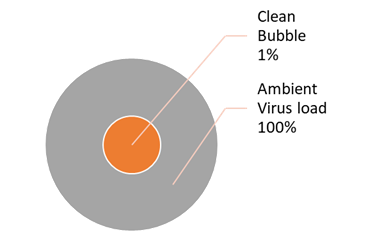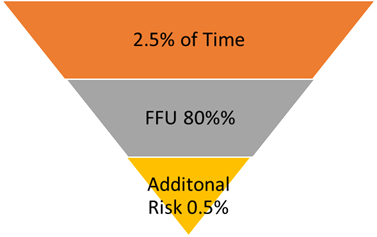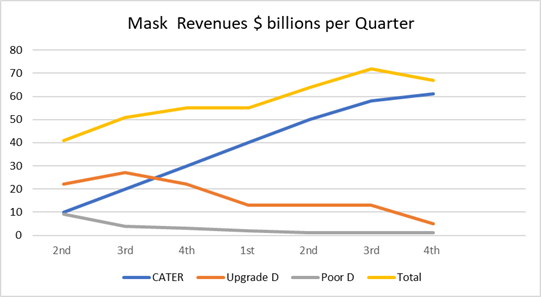
CATER Mask
Decisions
January 7, 2021
Clean Bubbles are the Short Term COVID Solution
Masks will Steadily Reduce Risk
Essential Role of Mask Suppliers
Contagious Variant Spreading
_____________________________________________________________________________
Clean Bubbles are the Short Term COVID Solution
More than 1% of people in the U.S. and several
other countries are presently infectious. The
percentage is growing in most countries as the
new variant virus spreads. Governments can react
by further restricting activity with lockdowns
and restricted access.
But there is another option which is the
Clean Bubble
There are laws which limit the individual
occupancy in a store or school to 25%. This
means that 25% of the virus load is still
present. With products which are available now
and are not prohibitively expensive 99% of the
virus can be captured. So the Clean Bubble will
be equivalent to a building with just 1%
occupancy. The 99% virus reduction compares
favorably to any other option whether it is
vaccines at 94% or partitions at a paltry 10%.

The foundation of the bubble is tight fitting
efficient masks. In areas where it is
inconvenient to be wearing the masks or where
excessive crowding is likely fan filter units
and air purifiers are needed. All space needs to
be monitored for particulate and CO2. Any
entrant to the safe bubble will be scrutinized
to insure that his mask is the correct type and
worn properly.
Clean bubble example:
A large department store operates a safe bubble.
Any entrant to the store will be checked to see
that he has a certified mask and that it is
being worn properly. If the entrant does not
qualify he can enter a store area with high air
filtration efficiency where he can buy a mask of
the right design and size. The store will offer
quantitative fit testing and provide him with
certification.
If there are 2000 people in the store on average
twenty of them will be infectious. The challenge
for any protective device is that the position
of the transmitter and recipient keep changing.
A partition has zero impact if the transmitter
is upwind of the recipient. The virus like
perfume just flows around the partition.
The one protective device which is always
between the transmitter and recipient is the
mask. In fact when both are wearing masks there
are two protection devices in between. Masks are
now available
with 90% Fitted Filter Efficiency (FFE).
If both transmitter and recipient are wearing
90% FFE masks the virus risk is reduced
by 99%.
Installing MERV 16 or better filters can capture
98% of the virus passing through but it will not
necessarily be between transmitter and recipient
but it could add an additional 0.5% risk
reduction to
99.5% .
General Area Risk Reduction

This brings the total risk reduction in the
general areas to 99.5%.
Assume that the average customer spends 5% of
his time in the food court. The odds are that
one infectious person will be in the food court
area.
If everyone is wearing their masks in
food lines and only removing them when at the
dining tables, the risk is further reduced.
Assume the dining area has ceiling fan filter
units which result in an 98% virus capture but
only 80% effectiveness due to the position of
the transmitter relative to recipients. The
transmitter has his mask off in the food court a
total of 2.5% of his store time. 80% of the
virus is removed. So the additional risk is
0.5%.

Food Court Risk
Therefore the total risk is 1% compared to a
store with no protection. The bubble is
relatively safe compared to any other practical
alternative
Masks will Steadily Reduce Risk
The above example was based on 20 infected
people in a group of 2000. If everyone wears a
tight fitting efficient mask routinely the ratio
of infected people will quickly fall from the 1%
level. When the infectious rate drops to 2 per
2000 the infection risk is reduced to 0.1%
compared to the present.
Essential Role of Mask Suppliers
Billions of people around the world are wearing
inefficient loose fitting masks.
If everyone were wearing tight fitting,
efficient masks schools, fitness centers, and
office buildings
would be 70 times safer than they are
now.

A Clean Bubble initiative will result in the
widespread use of Comfortable, Attractive, Tight
fitting Efficient CATER masks. Temporary
reliance on upgraded disposable masks with
components to insure a tight fit will also be
needed to create the clean bubbles. Use of poor
disposable (Poor D) masks will gradually
disappear.
A huge market of hundreds of billions of dollars
will be created very quickly. The route to
market will be radically changed. Presently
masks are sold on line without credible
information relative to performance. With the
Clean Bubble initiative, each Clean Bubble
operator will be involved in mask selection.
Meat processors, airlines, department stores
schools. office buildings movie theatres and
other building operators will be tasked with
making sure that each entrant has a mask which
not only has the performance characteristics but
is also being worn properly. The result will be
that most masks will be sold through the Clean
Bubble operators rather than on line.
McIlvaine is identifying the likely safe bubble
operators, the numbers of masks they can sell,
and the way they will be sold.
For an example, a large university can
create a safe bubble on a campus where students,
faculty, visitors, and service personnel can
total 100,000 people. The masks can be sold in
the University Store along with a service to
help select the right size and
provide fit checking.
Fitness centers can provide fit testing and
provide certificates that an individual is
wearing the right size of qualified mask. They
can also provide fit testing for other Clean
Bubble operators in their vicinity.
Meat processors, nursing homes, airlines,
hotels, and other facilities where people
congregate will combine screening with provision
of masks.
The McIlvaine Company with the Mask Supplier
Support Program is providing guidance on the
Clean Bubbles, identification of Clean Bubble
operators around the world and methods to
successfully market masks. For more information
on the program contact Bob McIlvaine at 847 226
2391 or rmcilvaine@mcilvainecompany.com.
Contagious Variant Spreading
The more contagious coronavirus variant that has
brought Britain to its knees in recent weeks is
showing signs that it is spreading widely
throughout the United States, health officials
and experts said this week.
So far, the reported cases have been mostly
isolated: one in New York, one in Florida, one
in Georgia and two in Colorado. But California
has been another story, with 32 cases of the
variant now reported in San Diego County.
"I would be surprised if that [number] doesn't
grow pretty rapidly," Dr. Francis Collins, head
of the National Institutes of Health, told the Washington
Post on Wednesday.
An official from the U.S. Centers for Disease
Control and Prevention agreed.
"Here at the CDC, we're definitely taking this
seriously, and we're assuming for now that this
variant is more transmissible," said Greg
Armstrong, the leader of the CDC's strain
surveillance program. The British variant "is
probably not in every state at this point, but I
think in a lot of states."
While the variant shows no signs of being more
deadly than the original version of the virus,
it could send more people into hospitals, up the
number of COVID-19 deaths, and prolong the
effort to reach herd immunity in this country,
the Post reported.
Herd immunity will be reached when the virus
encounters enough people with immunity that it
dies out. Unfortunately, the percentage of
people who need to be immune for a population to
achieve herd immunity is higher for more
infectious pathogens.
"We are in a race against time," said Jennifer
Nuzzo, an epidemiologist with the Johns Hopkins
Center for Health Security in Baltimore. "We
need to increase our speed in which we act so
that we don't allow this virus to spread further
and allow this variant to become the dominant
one in circulation. The clock is ticking."
In addition to the herd immunity issue, any
variants could limit the power of antibody
treatments because those treatments are so
narrowly focused.
The implications for vaccines are less clear in
the long run because the virus will continue to
mutate, though the consensus is that the new
coronavirus vaccines will likely still work
because they trigger the creation of a broad
array of neutralizing antibodies and other
immune system responses. In addition, the mRNA
(messenger RNA) vaccines from Pfizer and Moderna
can be altered if necessary, the Post reported.
Still, the need to vaccinate as many people as
possible as quickly as possible has become more
urgent, and some scientists have argued that
cutting doses in half or delaying the second
dose might be necessary to reach that goal. But
the U.S. Food and Drug Administration this week
said it would stick with the two-shot dose
backed by randomized clinical trials.
